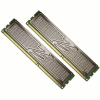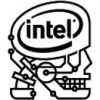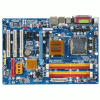- Qualcomm Launches Snapdragon 4 Gen 2 Mobile Platform
- AMD Launches Ryzen PRO 7000 Series Mobile & Desktop Platform
- Intel Launches Sleek Single-Slot Arc Pro A60 Workstation Graphics Card
- NVIDIA Announces Latest Ada Lovelace Additions: GeForce RTX 4060 Ti & RTX 4060
- Maxon Redshift With AMD Radeon GPU Rendering Support Now Available
Content and news by Rob Williams

Rob's Recent Content
OCZ Offers Up a Fast 4GB DDR2 Kit
Maxing out your machine with lots of RAM has never been easier, thanks in part to cheap DDR2 parts. Last year, 8GB of RAM would have set you back at least $600, but now, prices have dwindled to the extent of that being possible for as low as $200. It’s truly incredible, and a huge draw for all consumers to go overboard with their memory configuration.
Thanks to OCZ, that 8GB of installed RAM no longer has to be slow. Their new Reaper HPC DDR2-1066 improves upon the DDR2-800 kits last year that were considered “high-end”. Pricing is not mentioned in the press release, but it will no doubt hover around the $200 mark. One things for sure though, a high-end motherboard will be required if 8GB of RAM at stock speeds is planned. Low-end boards will be unlikely able to handle that type of stress.

|
“In order to maximize the system performance, especially in the latest games, 4GB of memory are more and more becoming a must have…but it is also necessary to maintain the throughput regardless of the increase in density. The new PC2-8500 Reaper HPC 4GB kits combine the best of two worlds by delivering extreme bandwidth at 1066 MHz data frequency at 5-5-5 latencies, in combination with advanced heatpipe-based thermal management to again raise the bar for high system memory densities.”
Source: OCZ Press Release
Published on February 11, 2008OCZ 2GB DDR3-1600 Titanium – Intel XMP Edition
DDR3 might be slow to catch on, but the competition is fierce and the selection, huge. One of the first DDR3 kits to really catch my eye was OCZ’s Titanium 2GB PC3-12800, featuring an XMP profile to offer even better settings than what are advertised. Luckily, it also has some OC’ing room to boot.
Published on February 7, 2008Intel’s Skulltrail Dual Quad-Core Platform Preview
Ever since Intel first released their Core 2 Duo processors, AMD has been struggling to keep up. Though their Phenom launch went fine overall, it failed to retake the throne from the big blue, and Intel is taking every advantage to keep things that way. Their next move? Skulltrail.
In case you happened to have missed it, we posted a preview today of Intel’s upcoming platform, which consists of a D5400XS (Desktop 5400 Extreme Series) and two Quad-Core processors. The ones used in the review are the same models that will be marketed alongside the platform, the Core 2 Extreme QX9775, clocked at 3.2GHz. In laymens terms, it’s OMG! powerful.
The platform utilizes FB-DIMM memory, which seems like an odd choice given the target audience, but the entire platform overall is extremely stable, which is Intel’s highest concern. Or at least it would seem that way – just ignore the 1.9Vcore possibility in the BIOS. Other features include support for NVIDIA’s SLI and AMD’s Crossfire, resulting in quite a bit of flexibility.
We were unable to cover a few points that we wanted to in time of publishing, so we will be following up with a few other pieces of related content prior to launch. Stay tuned.
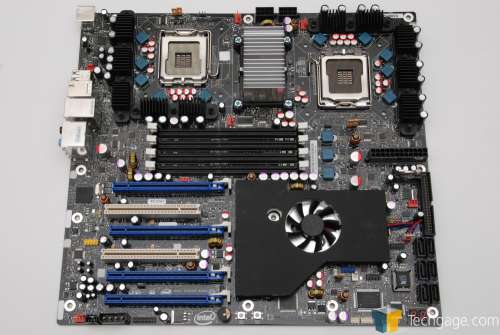
|
Where Skulltrail is concerned, great possibilities arise. Up until now, such a platform has been unavailable for the regular enthusiast, whether it be an overclocking or gaming enthsusiast, but Skulltrail promises to feed the insatiable need of those who thrive on having more power. Does it deliver on its promises? It does, as long as you have the means to feed it.
Source: Intel Skulltrail Preview
Published on February 4, 2008ASUS Xonar and Ultrasone PRO 750’s Under Linux
Two weeks ago, I posted about using CMI8788-based sound cards under Linux, with a status report of my personal experiences. Not much has changed since then, although the developer, Clemens Ladisch has released a few subsequent beta drivers, the most current being from Jan 30. Though still considered a beta, it’s noted that the driver is “almost 100%”.
In the last post, I mentioned that I didn’t have an abundance of mixers available, as I’ve seen others have, but I believe it’s due to the fact I am using the PCI-e version of the card. I could be wrong, but I am out of other ideas.
That said, I’ve since picked up a pair of Ultrasone PRO 750s, the company’s recent upgrade to the PROline 750. I’m no audiophile, but I can already recommend picking up a good pair of headphones for use with the Xonar under Linux… the quality is truly incredible. These headphones haven’t gone through a proper break-in period, so I will be able to comment more next week.

|
Regardless of that though, the headphones sound incredible, and the Xonar works well, despite the lack of overall mixers. I performed quick tests between Windows and Linux, and neither had an obvious advantage. What will lack is the inability to use special Dolby effects like the Windows drivers include, but I personally found a more enjoyable sound without any sort of software manipulation.
Even with only a few weeks worth of experience, I can already recommend picking up an CMI8788-based card to anyone running Linux and who are looking for a richer audio experience. Hit up the link below to read Rory’s review of the card from September.
Source: ASUS Xonar D2 Review
Published on February 4, 2008Intel Skulltrail Enthusiast Platform Preview
Consisting of two Extreme Quad-Core processors, Intel is looking to redefine what we know as “high-end”. Skulltrail is touted as being the “ultimate” enthusiast platform, offering SLI and Crossfire support, huge overclocking abilities and enough sheer power to make the competition weep.
Published on February 4, 2008NY Giants Win Superbowl, End Patriots Winning Streak
To the chagrin of Patriot fans all over (and the euphoria for anyone in Indiana state), the New York Giants have taken home the Lombardi Trophy, and a well-deserved one at that. It could be argued that most of the game was rather laid-back, but the last ten minutes were anything but. The Patriots looked to have the game locked down, but thanks to a perfect pass from Manning to Burress, the game officially belonged to the Giants.
Peyton Manning may be considered one of the best Quarterbacks of all time, but Eli is certainly headed down the same path, proven by last nights game. As a follow-up to the match, ESPN has a write-up of ten things learned from the game, with my personal favorite being “Tom Brady is human”. Indeed, the way he took what seemed like twenty hits during the game noticeably shook him up and didn’t bode well for the Patriots outcome.
Congrats to the Giants for an excellent victory.

|
He was hit on more than half of his first 17 pass attempts in the first half alone — the Giants sacked him three times and knocked him down six other times — and Brady actually looked rattled at times. He couldn’t stand in the pocket long enough to throw deep to Moss, and he even seemed confused at times. The bottom line: Brady faced his toughest challenge of the season at the worst possible time (he was sacked five times).
Source: ESPN
Published on February 4, 2008Valve Releases Free Steamworks Platform for Game Developers
Valve announced something the other day that was actually quite interesting. Called Steamworks, the platform is designed to help game developers out and let them focus on what’s important… the game. Steamworks takes out the hassle of all the boring stuff that surrounds game publishing, including copy protection, installation methods, auto-updaters, news alerts and the like, by offering an all-in-one platform that’s entirely customizable. So, if a developer chooses to use it, the end-user won’t even know that it’s built on the Steamworks platform.
This is a fantastic idea and one that’s going to be appreciated by many. I don’t necessarily agree with all of how Steam handles things, but a -free- platform like this is going to save developers many hours of anguish, and instead put that time to good use… by creating a great game. It’s a smart move for Valve as well, since many of these developers will be encouraged to sell their game through Steam. It seems like a win/win.

|
Developers are going to be able to skin this stuff so that it’s basically invisible to the user. If they used Steamworks on their disc and didn’t use Steam to distribute you’d install, then have a box come up and say “hey, you have to create this account and unlock the game†and they’d launch and go into the game. The only time you’d see Steam was in creating an account, everything else can be reskinned, auto-updating will be transparent to the user already.
Source: Rock, Paper, Shotgun
Published on January 31, 2008eBay Sellers Upset at New Rates
I received an e-mail from eBay the other day, noting lower rates. After I picked up my jaw and scratched my head due to confusion, I simply accepted the fact that “feebay” decided to begin pleasing their sellers, instead of making them irate. But it looks like I spoke too soon, as it appears the fees are speculated to do a lot more harm than good.
Bloggers all around the web are gathering together and speaking against the new rates. According to Ina Steiner, of Auction Bytes, the new rates could increase some sellers fees by as much as 33%, despite eBay claiming that 60% of sellers should enjoy lower rates.
It might take a few weeks before the real effects are seen, but so far, things are not looking too good.

|
“Every seller’s going to have to go back and review their business practices and see what this means for them individually,” said eBay spokesman Usher Lieberman. It isn’t just the fee structure that has sellers out of sorts: eBay also changed its feedback system so that sellers cannot give a negative or neutral rating to buyers.
Source: Epicenter Blog
Published on January 31, 2008Intel Core 2 Duo E8400 3.0GHz – Wolfdale Arrives
Intel’s 45nm Dual-Cores have finally arrived, so it’s only fitting that we take one for a spin. Our test subject is the 3.0GHz E8400, offering 6MB cache, SSE4 and more. Overclocking is impressive, with 3.8GHz stable being possible without even raising the voltage! This chip definitely proves itself a winner.
Published on January 30, 2008Autoblog Drives the Tesla Roadster
If there is one car that has been getting a lot of publicity over the past year, it would be the electric-powered Tesla Roadster. It’s all for good reason, too. Easy on gas, better for the environment… and best of all, it’s gorgeous. Until now, not many from the press have been able to take the car for a spin, but Damon at Autoblog managed to get behind the seat for a good 100 miles.
The car, being electric, responds to the road far different than what seems normal. The Roadster can accelerate while going uphill without skipping a beat – no need to shift. On top of that, it’s fun to drive, just like the Lotus Elise, on which it’s based. The comfort level is not mentioned, but it must be better than the Elise, which is like driving a box.
The review is good, and so are the included videos. If only I had $98,000 hanging around…
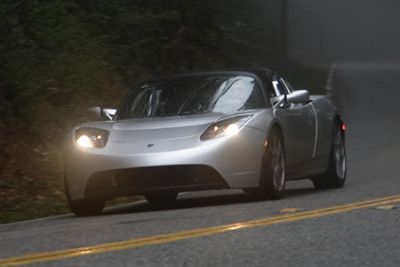
|
First reaction: My God, I’m in a Lotus. No surprise considering that the Tesla is built along side the Elise at the Hethel production facility. The MOMO steering wheel, seats and dash are all carryovers from the donor car, but the carbon fiber transmission tunnel, carpeting and gauge cluster are all specific to the Tesla. And about that gauge cluster… A 13,500 rpm redline causes a grin reminiscent of Jack Nicholson, post-chemical plant explosion.
Source: Autoblog
Published on January 29, 2008Nikon Announces D60 D-SLR
Whenever Nikon sends a release along the wire, I tend to get excited. The inner Nikonian comes out and I eat every word. This time was a little different though. The D60, at first glance, doesn’t look like much more than a D40 or D40x, but looking closer, there is luckily more to the picture.
The D60 shares the same body as the D40 and D40x, and also includes the same 10.2MP sensor of the latter. The EXPEED image processor found on the D3/D300 is included here though, but that’s all that seems to be shared. There is no live-view screen and no additional focus-points (still three). What it does have though, is a dust-reduction feature… and about time too.
Perhaps one of the nicest features is the new kit lens. It’s almost identical to the D40/D40x kit lens, except it has Vibration Reduction built-in, a technology that’s becoming ever more popular and is resulting in lower prices – a huge win for the consumer. Sadly, pricing of the D60 is not known, and won’t be until PMA, probably, but it will no doubt hover around the same price-point as the D40x. Overall, a solid launch, but the competition seem to be the winner here. If not for any other reason… the lack of the live view is a huge hit.
You can read all of today’s Nikon press releases on their site here, and if you want to just see more of the D60, the gallery is here.
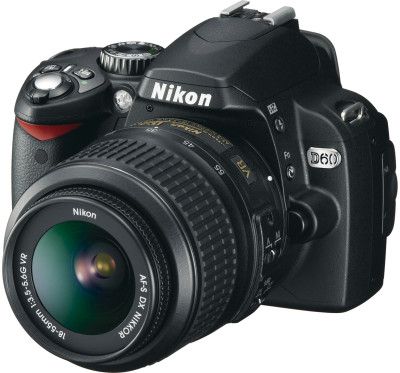
|
Such clarity is reinforced by Nikon’s dust reduction countermeasures. To avoid picture-degrading dust particles accumulating near the imaging sensor, the D60 comes equipped with the innovative Image Sensor Cleaning function and Nikon’s exclusive Airflow Control System. These functions both reduce dust accumulation to give you even better picture quality.
Source: Nikon Imaging
Published on January 29, 2008Gigabyte GA-P31-DS3L
There are few P31-based motherboards on the market, but as we find out, they are well-deserving of some attention. The board we are taking a look at today hovers around $100, but despite it’s value status, it’s a great offering.
Published on January 29, 2008Fresh 9800GX2 Pictures Leaked
There have been a few websites to leak G92 pictures in the past month, but Chinese site ChipHell has those all beat with a few shots of their own. These images come at a perfect time, since AMD’s HD 3870 X2 launch was just yesterday. The first fact most people were posing was this… NVIDIA’s dual-GPU solution would no doubt beat AMD’s offering. From a technical standpoint, that might be true, but it sure isn’t true where looks are concerned.
The 9800GX2, unlike the HD 3870 X2, will consist of two PCB boards, a la 7950GX2. This seems reasonable, since it worked the first time. However, if AMD managed to create an elegant solution such as the single-PCB 3870 X2, why did NVIDIA stick to dual-PCBs? It might all work the same, but the finished result is certainly unrefined.

|
In all fairness though, these images are not exactly representative of the final product. In fact, they are plain disgusting, with gobs of thermal paste all over the place. Hopefully the retail product will change my mind. In the end though, looks don’t matter. It’s the performance that does, and we should know more about that in the coming weeks.
Source: VR-Zone
Published on January 29, 2008Windows 7 Could be Launched in 2011
Last week, I linked to a rumor that Windows 7, the next version of our beloved OS, would potentially be released in late 2009 – only three years after Vista. But, as is becoming far too common lately, it turns out the rumor was fully unsubstantiated and has been debunked by the fellows at Redmond:
“We are currently in the planning stages for Windows 7 and expect it will take approximately 3 years to develop. The specific release date will be determined once the company meets its quality bar for release.”
Three years, for the uninitiated, would bring us to 2011. I don’t know about you, but I am certainly not in a hurry for Vista’s follow-up, and I believe Microsoft needs all the time they can get to make sure it’s not as disappointing as Vista’s launch was.
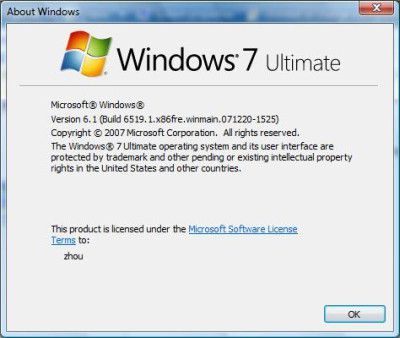
|
Contrary to all that is being said on the net, it clearly looks like Microsoft is NOT planning to release Windows 7 in 2009. Microsoft’s official response, by an Email dated 26th January, 2008, to WinVistaClub states that Windows 7 is still in the planning stage and will take approximately 3 years to develop. The following is the extract of the mail:
Source: WinVistaClub
Published on January 29, 2008AMD Releases Dual-GPU on a Single Card: HD 3870 X2
The past year for AMD’s graphics division hasn’t exactly been that peachy, but things began to shape up with the launch of the mid-range 3850 and 3870 cards a few months ago. The problem with that launch, though, was the fact that both cards were mid-range… with no high-end offering to be found. On the NVIDIA front though, they’ve consistently offered high-end cards that put AMD’s skus to shame.
Thanks to a fresh launch today though, AMD’s high-end drought is finally over. The HD 3870 X2 gives itself away with the title. It’s essentially two 3870 GPUs thrown together on the same PCB, with revised power delivery and a PCI-E bridge-chip built-in. Simple in theory, but the proof is in the pudding. Although the card eats more power than an 8800GTX, it makes up for it with the performance/power-gobbling ratio. Indeed… I’ve been proud of my single 8800GTX card for a while now, but the HD 3870 X2 has my mind effectively changed.
The good thing about the 3870 X2 is that it can be used on any motherboard. The chipset doesn’t matter… and you don’t need to use a bridge in order to access the extreme performance. That’s where another downside lies though – this card cannot be used in CrossfireX mode due to infant drivers, but those should be taken care of by March.
From a performance/$ perspective, this card delivers. It will retail for $449, more than an 8800GTS but less than a GTX, and it outperforms them both. Indeed, the only thing that can beat the single HD 3870 X2 is NVIDIA cards in SLI, such as the 8800GT. But that leads to another issue. While AMD now currently holds the top-spot for performance on a single card, it was achieved by using two GPUs. This is something NVIDIA is more than capable of doing, and given performance of the 8800GT in SLI mode, making an “X2” version of that card and selling it at the same price point… AMD would once again be out of the limelight.
Regardless, this is a fantastic launch from AMD and it’s great to see they’ve got their groove-back *high clap*. For now at least. We really need a new high-end single GPU to know this for sure.

|
Because the Radeon HD 3870 X2 is essentially “CrossFire on a card”, the X2’s performance is determined by how well the card’s drivers scale in a particular game. If a new game hits store shelves and the drivers don’t recognize the executable, the $449-$499 Radeon HD 3870 X2 will perform much like a single-GPU Radeon HD 3870 that is half the price. ATI assures us their software team will try to minimize this situation, but it will be an issue at some point in time no matter how hard they work unless a universally compatible multi-GPU rendering technique is devised.
Source: HotHardware, AnandTech and Tech Report
Published on January 28, 2008Amazon MP3 Store to go International This Year
Since Amazon launched their online music store last September, they’ve done a great job of getting the attention they need, from both consumers and record companies alike. They now carry music from all four of the major labels and offer over 3 million songs, given them a steep advantage over iTunes and other competitors.
As it stands though, the service is available in the US only, but later this year, the service will be available internationally. Once that happens, Amazon’s name should become synonymous with online music sales rather quickly. They will have more music than anyone and will sell each track for market-standard prices… sounds good to me. As a Linux user, I don’t have much choice with regards to downloadable music, so I am looking forward to being able to use this service myself. They seem to be doing everything right. I just hope it keeps that way.

|
Amazon currently provides 3.3M songs from 270,000+ artists, encoded at 256kbps, and priced anywhere between 89 and 99 cents each. Things are similar with iTunes Plus, Apple’s DRM-free music collection: songs are 99 cents each and encoded at 256kbps. However, Apple only provides “up to 2 million iTunes Plus songs” in comparison to Amazon’s 3.3M, giving the latter company a substantial edge with its scope.
Source: TechCrunch
Published on January 28, 2008Is HD DVD Dead? Promotional Group Sure Doesn’t Think So
HD DVD sure can’t catch a break since Warner’s decision to cease production on the format. If that decision wasn’t enough to let people know that HD DVD was on the way out, the recent reports of the massive hardware sales decline sure helped. But, despite HD DVD going downhill, there is…..
Published on January 28, 2008Intel’s X48 Unlocks Insane Tweaking-Abilities
We’ve discussed Intel’s imminent X48 launch for a few months now, but the date is coming ever closer. Two to three weeks is the given estimate, and from what we can see, it’s going to be one refreshing “refresh”. AnandTech has taken the new ASUS Rampage Formula for a spin and are incredibly pleased with it’s performance and tweaking ability.
That’s no understatement. By the looks of things, the Rampage will be the definitive tweaking motherboard, opening up new features such as tRD and tweak it’s various settings. I admit, even current motherboards are too over-the-top for me… I appreciate the time I have and would rather not be stuck in front of an overclocking screen, but there are clearly many out there who love to squeeze as much possible performance out of their hardware – the Rampage is for you guys.
This article takes an exhausting look at tRD and how it works, but also takes care of simpler things, such as how to calculate DDR speeds, latencies and the like. But the question is… does all this tweaking ability really make a difference? In the case of tRD, it certainly does. Huge gains can be seen in the memory bandwidth and latency department… making it a setting any enthusiast will want to dabble with. This is definitely X48’s best-kept secret.

|
Using the default tRD of 12, our system was able to reach a maximum memory read bandwidth value of 7,597 MB/s – a predictable result considering the rather relaxed configuration. Tightening tRD all the way to a setting of 5 provides us with dramatically different results: 9,166 MB/s, more than 20% higher total throughput!
Source: AnandTech
Published on January 28, 2008Gigabyte and MSI Announce X48 Boards, But Not Launch
When will we see Intel X48? That is the question, and a good one. At this point, I am not sure when the market penetration will begin, but it should be within the next two – three weeks, but that’s a hunch. I’ll be receiving the Gigabyte board (pictured) shortly, so I assume that the launch is not too far off. According to industry tracking site DigiTimes, both Gigabyte and MSI have announced their new motherboards, but neither are prepared to deliver them, at least not immediately.
I am unsure where ASUS is with their X48 samples, but I believe their boards are going to be delayed by an additional week, similar to the X38 launch. Why this is, I believe is linked to the fact that they want to put in a little extra time, since their launch boards tend to be very feature-rich. Gigabyte’s launch X48 board should be interesting as well though, as they include their new Dynamic Energy Saver technology that does as you’d expect. Every little bit helps when you have 200W GPUs, I suppose.
You can expect our X48 coverage in the weeks to come, as samples are brought in.

|
Gigabyte Technology recently announced its X48 motherboard highlighting it will adopt the company’s unique Dynamic Energy Saver (DES) technology, while Micro-Star International (MSI) also made the announcement that its X48 motherboard will adopt the same dual-channel power supply design as that in its X38 model for better power management. MSI’s board will also feature an updated Circu-Pipe fansink and MSI SkyTel technology.
Source: DigiTimes
Published on January 25, 2008Exploring DisplayLink – Video via USB
For those who missed it, we posted an article yesterday which explores a new technology called DisplayLink. Simply put, DisplayLink adapters allow you to extend your current computer setup by adding additional displays, with the help of USB. As ridiculous as it sounds, it works, and worked rather well.
The downside is that the adapters will run about $100, but that’s better than purchasing a new GPU for some people. Past that though, many of us have old monitors chucked in a closet which could be put to use, so DisplayLink is one method of getting it done. If you happen to be a die-hard multi-tasker, you could even hook upwards of six monitors… five being through USB. Despite me personally having no need for it, it’s an impressive technology and one I was happy to award our Best of CES 2008 award to.

|
To understand why USB video is relevant, you first have to understand that this is not a technology set out to replace VGA or DVI if you have a system with a single monitor. If that’s the case, then it makes no sense to rely on USB, as VGA and DVI are faster and will allow full capabilities. USB on the other hand, is there for those people who either a) don’t have a spare video port on their computer, b) don’t want to install (or pay for) a second GPU and/or c) require two or more monitors.
Source: DisplayLink – Multi-Display Setups with USB
Published on January 25, 2008Older Entries
Newer Entries
Copyright © 2005-2025 Techgage Networks - All Rights Reserved.
About Us | Advertise | Terms & Conditions | Privacy Policy




